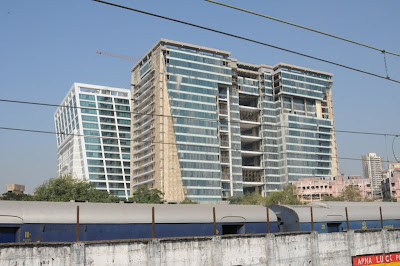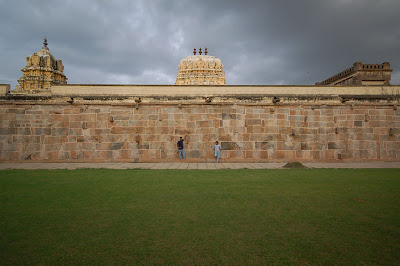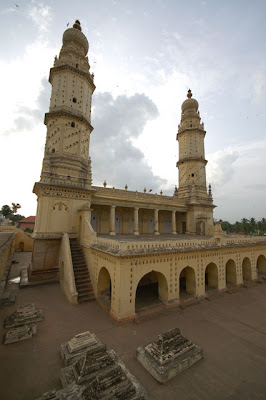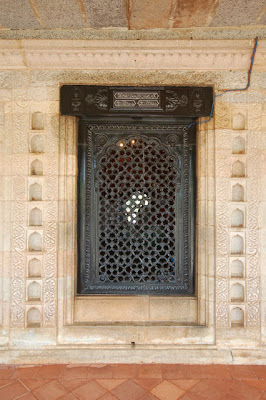Haven't you wondered what if you went back.. Back to a place where you had spend a few beautiful years of your life.. Back to where you found some the most important people in your life.. Back to a place who's memories you treasure dearly.. Haven't you wondered how it would be to go back into your own past.. Would u end up in the same place? Over the past one year I've done more than my share of this search for the past. It took me back to Dubai - a city I recognize but yet isn't the one I can call mine! - It took me to Kerala - to a motherland that I could never really make any claims to - and now it's bought me back here - to Bombay!

 I was last here 3 years back - and that was only for two days .. so essentially this is my first real trip since I left here in July of 2005..
I was last here 3 years back - and that was only for two days .. so essentially this is my first real trip since I left here in July of 2005..
At first glance a lot seems to have changed - lots of new buildings, soo much cosmetic surgery to it's airports that it almost fooled me to believe that it actually works better, a much talked about (and way too over-rated) sea link....
 many many new towers have come up in what used to be the industrial mill lands of central Bombay..
many many new towers have come up in what used to be the industrial mill lands of central Bombay..
 and of course the predictable sprouting of new shopping malls across the city.. And so on..
and of course the predictable sprouting of new shopping malls across the city.. And so on..  inside Oberoi Mall
inside Oberoi Mall
Here's a few more random photos... Lalbaugh
Lalbaugh
 the building rising above is Mukesh Ambani's personal residential tower
the building rising above is Mukesh Ambani's personal residential tower
 Building in Lalbaugh
Building in Lalbaugh

 View from the Sea-link
View from the Sea-link
More new buildings in Central Mumbai



 On closer inspection, except for the city getting a lot more - noisy, polluted and expensive nothing has really changed!
On closer inspection, except for the city getting a lot more - noisy, polluted and expensive nothing has really changed!
 Now I'm not sure myself of what change I expected? Do cities change that fast .. Or do cities change at all? May be I hoped that in the last few years the leadership of the city would have finally started to care for it's citizens!
Now I'm not sure myself of what change I expected? Do cities change that fast .. Or do cities change at all? May be I hoped that in the last few years the leadership of the city would have finally started to care for it's citizens!
So as I contemplate moving back here.. to take up a job ... Bombay seems to have become even more difficult and inhumane... the price of everyday stuff has almost tripled in the last four years.. renting a decent house close to work is now almost impossible (of course that's assuming that most of the jobs are still based in South Bombay).. the traffic situation in the city 4 years back was as bad as it could get so that hasn't really changed .. the city is a lot more polluted .. the stink a lot stronger.. and the streets louder..
Yet the damn lure of the familiar!

 I was last here 3 years back - and that was only for two days .. so essentially this is my first real trip since I left here in July of 2005..
I was last here 3 years back - and that was only for two days .. so essentially this is my first real trip since I left here in July of 2005..At first glance a lot seems to have changed - lots of new buildings, soo much cosmetic surgery to it's airports that it almost fooled me to believe that it actually works better, a much talked about (and way too over-rated) sea link....
 many many new towers have come up in what used to be the industrial mill lands of central Bombay..
many many new towers have come up in what used to be the industrial mill lands of central Bombay.. and of course the predictable sprouting of new shopping malls across the city.. And so on..
and of course the predictable sprouting of new shopping malls across the city.. And so on..  inside Oberoi Mall
inside Oberoi MallHere's a few more random photos...
 Lalbaugh
Lalbaugh the building rising above is Mukesh Ambani's personal residential tower
the building rising above is Mukesh Ambani's personal residential tower Building in Lalbaugh
Building in Lalbaugh
 View from the Sea-link
View from the Sea-linkMore new buildings in Central Mumbai



 On closer inspection, except for the city getting a lot more - noisy, polluted and expensive nothing has really changed!
On closer inspection, except for the city getting a lot more - noisy, polluted and expensive nothing has really changed!  Now I'm not sure myself of what change I expected? Do cities change that fast .. Or do cities change at all? May be I hoped that in the last few years the leadership of the city would have finally started to care for it's citizens!
Now I'm not sure myself of what change I expected? Do cities change that fast .. Or do cities change at all? May be I hoped that in the last few years the leadership of the city would have finally started to care for it's citizens!So as I contemplate moving back here.. to take up a job ... Bombay seems to have become even more difficult and inhumane... the price of everyday stuff has almost tripled in the last four years.. renting a decent house close to work is now almost impossible (of course that's assuming that most of the jobs are still based in South Bombay).. the traffic situation in the city 4 years back was as bad as it could get so that hasn't really changed .. the city is a lot more polluted .. the stink a lot stronger.. and the streets louder..
Yet the damn lure of the familiar!







































